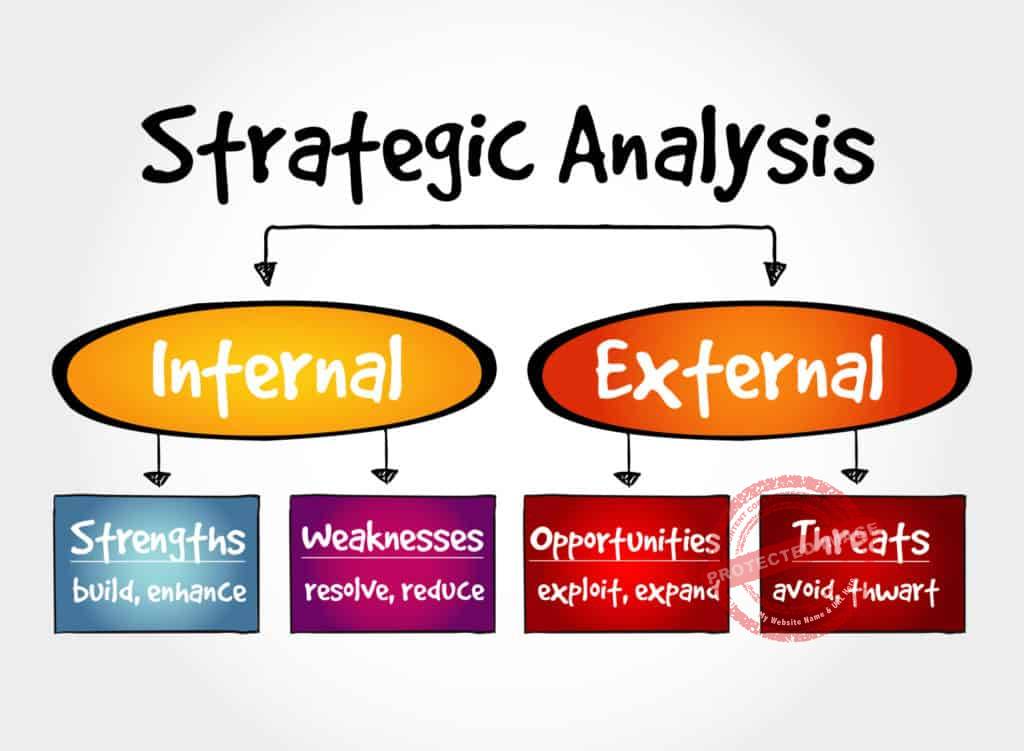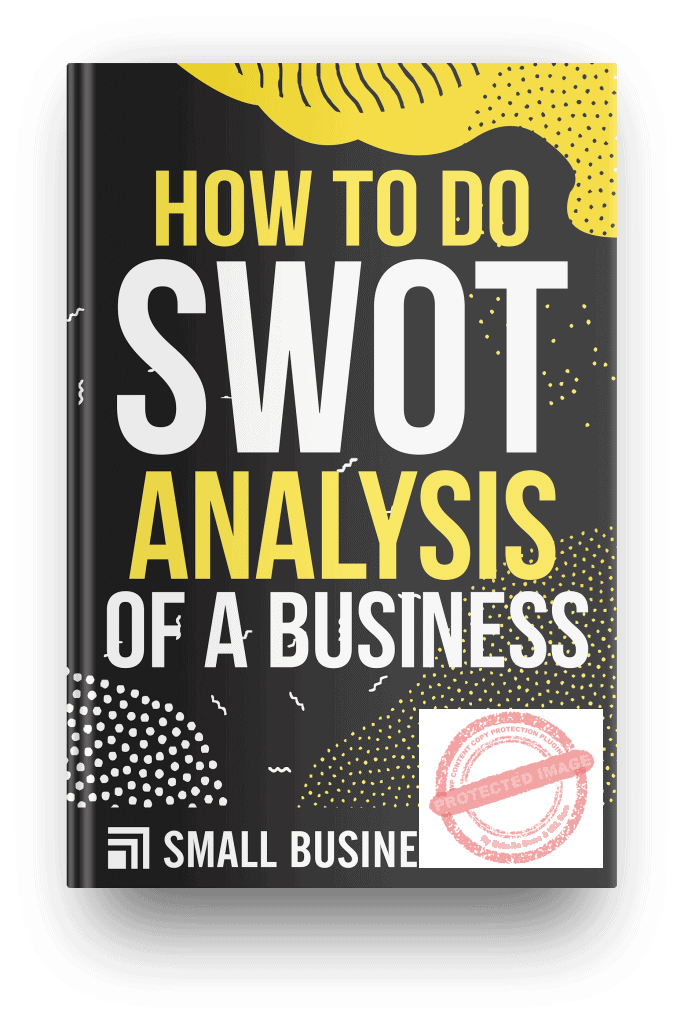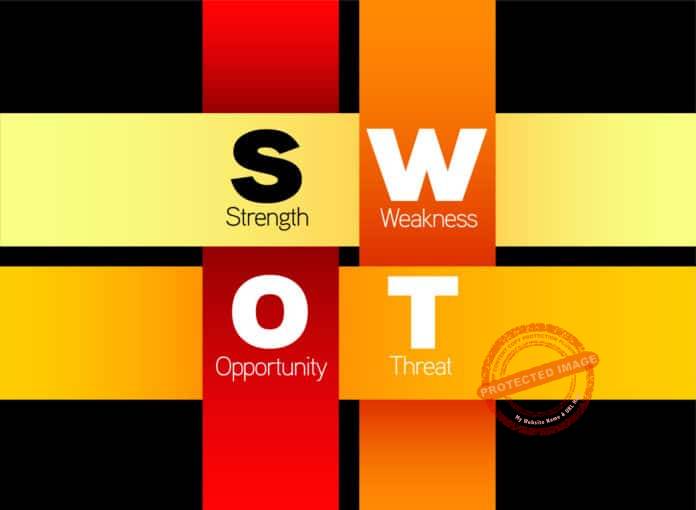So you need to know how to do the SWOT analysis of a business. SWOT stands for Strengths, Weaknesses, Opportunities & Threats.
Doing a SWOT analysis of your business will help you identify its strengths, weaknesses, opportunities & threats.
Many business owners believe putting in money into a venture guarantees success.
Stuck with an idea, they launch their product without finding out if there is a market for it.
They believe they can persuade people to buy their products.
Statistics show that 90% of the companies fail within the first to the fifth year of operation.
Of the 90%, 42% fail from the lack of a market need for the product.
The other 23% fail because of getting the wrong people.
Still, 19% of businesses get clobbered by the competition.
As a business owner, you should consider the importance of knowing the internal and external environment.
Knowledge of the environment allows you to meet challenges.
The right information prevents failures and reduces drawbacks.
A valuable tool for scanning the environment doing the SWOT analysis of your business.
Doing a SWOT analysis provides you with certain detailed information about your business.
It can also find solutions to possible problems.
Why Businesses Fail

Running a business has its uncertainties and risks are part of doing business.
Failure to recognize the risks can harm your company.
If we go by the statistics, nine out of ten businesses are likely to fail.
Further, 50% of new businesses survive after five years, and only one third survive after ten years.
Many entrepreneurs write about their experience after failing in their business endeavors.
You, along with other business owners, investors, business leaders, and corporations can learn from their stories.
The SWOT analysis of a business allows you to study consequences that lead or may lead to failure.
The reasons given below are not intended to discourage you.
However, the information allows you to make plans of action to ensure success.
Absence or Lack of Market Need

This reason ranks top in business failures at 42%.
If the market does not have a need for your product and/or service, the business is bound to fail.
Lack of Money
Money is limited and runs out in the course of business operations.
The crucial question is how can you spend the money and still earn a large profit for the business.
Running out of cash alone is not a reason for failure.
Money problems in business are associated with the right fit for market and product.
Therefore, failure to change direction when necessary is another reason for you to run out of cash.
The Wrong Team
When your team cannot work together, the result would be damaging to the business.
There was once a business owner whose post-mortem note lamented the absence of a partner.
The partner could have served as a balancing factor in business decisions.
Inability to Compete In the Market

Most experts advise new and struggling businesses to ignore the competition.
Truth is, if you are a business owner, you should be aware of your competition.
This allows you to assess the status of your business and how your products fare against your competitor’s products.
Pricing and Cost Issues
Setting a price tag can be tricky.
You cannot afford to manufacture products that the target market won’t be able to afford.
You need to find the balance by setting a reasonable price that will give profits.
Products That Do Not Satisfy Needs
Business is sure to fail if your company ignores the users’ needs and wants.
It does not matter if ignoring customers is intentional or accidental.
The Absence of a Business Framework
Having a business model is crucial to your business.
Being glued to a single channel is disadvantageous for your business as well.
As one post-mortem note wrote, “the company failed to scale because of the single-channel”.
A Weak Marketing Strategy

You should identify the target customers.
Your marketing efforts should be centered on attracting potential customers and converting their interest into profits.
Poor marketing strategy is a leading cause of business failure.
An excellent product can become insignificant if your target is not aware such a product exists.
Ignoring Customers
Ignoring your customers shows you have a tunnel vision.
Some entrepreneurs consider collecting user feedback as a waste of time.
Most leading businesses know their target audience.
They listen to them and provide them with what they want.
Product timing
You should study when to schedule the release of your products.
Understanding SWOT

SWOT takes the initial letters of the words:
Strengths
Weaknesses
Opportunities
Threats.
The purpose of performing the SWOT analysis of a business is to analyze information that influences the business.
The internal environment refers to the strengths and weaknesses of your company.
The external environment points to the opportunities and threats it faces.
SWOT is an investigative plan for scanning the environment which serves many purposes, among which are:
- Investment opportunities
- Evaluation of competitors
- Activity, service, or resource outsourcing
- Business and strategic planning
- Product development
- Marketing
- Research reports
- Sales distribution

The appeal of SWOT to business leaders is its value and simplicity in identifying key concerns that affect the business.
If done with straightforwardness, the SWOT analysis of a business can help you identify what can and cannot be done to ensure success.
It can also identify factors that can provide potential growth for your company and increase its profits.
The Components of SWOT

Analyzing the business environment’s internal factors is tough for the owner.
You cannot avoid being subjective when doing self-analysis, be it personal or business.
If SWOT is to succeed in its purpose, your analysis needs to be objective and realistic about the company’s good and bad points.
Furthermore, the analysis should be specific in identifying the gray areas and connect them with real contexts.
An example is, comparing your company’s products and services with those of your competitors.
For the fact that data and information collected could be subjective, over-analysis should be avoided.
Instead, you should make the analysis brief and simple.
Strength

Here, your company’s strong traits and features are identified.
They are the internal touchable and untouchable characteristics of your business.
It also includes the views and perceptions of your customers about the company and its products.
Weakness
The weaknesses are the barriers that block your company’s top performance.
It discusses the areas that need improvement.
Furthermore, it gathers information from your customers’ opinions and other stakeholders.
Opportunity
The opportunities are the favorable elements outside your business.
You can use these elements to gain a competitive edge in the market.
An example is where a manufacturer exports cars in a new market.
This move could increase his company’s market share and increase sales.
Threat
Threats are the factors that may affect your business negatively.
Why Do a SWOT Analysis?

The SWOT analysis of a business is important and also a good tool to enhance business success.
Below are some reasons why a SWOT is done.
Efficient Use of Resources
The resources in business are limited, such as personnel, capital, and production capacity.
Therefore, evaluating your business’ strengths, weaknesses, opportunities, and threats help you to effectively allocate these resources.
The knowledge you gain from the evaluation will allow you to maximize your potentials for profit and revenue.
Improving Operations
Assessing your company’s weaknesses can identify critical areas needing improvement.
Thereby giving your business a competitive edge in the market.
An objective assessment of its weaknesses in real-life contexts can prevent mistakes.
An example is where a product which is inferior compared to your competitors’ similar products is still launched in the market.
Finding Opportunities

It is often necessary to look for new markets if your business is to grow.
The opportunities could be in the form of new customer groups, product development, the broader distribution of the product, and geographic expansion.
In addition, discovering opportunities allow your team to pinpoint emerging opportunities and take advantage of these early.
Deal With Risks
Threats are beyond your control, yet they can impact your business.
The SWOT analysis of a business allows the management to formulate contingency plans that they can act on when the risks become realities.
Competitive Positioning
SWOT analysis of your company can provide you with valuable information about your competitors.
Given the information gathered, your company can then position itself against its competitors.
Competitive positioning is possible when your competitors’ weaknesses become clear.
You can then challenge your competitors’ weaknesses using your business’ strengths.
Applicability

You can apply SWOT analysis in any aspect of a business.
This includes evaluating a brand or product, outsourcing a business function, assessing a supply source, and evaluating a business process.
The Simplicity of the Technique
Your team need not have the training or the technical skills to apply SWOT analysis in business.
Anyone in your company can evaluate the environment.
You can carry out a brainstorming process in your company with a favorable result.
A participating person’s judgment and beliefs are incorporated into collective judgment.
The knowledge of one person becomes the group’s knowledge.
How To Do a SWOT Analysis Of a Business

It is not difficult to perform a SWOT analysis.
It is easy and can be done by an individual or a team.
Here are the easy steps:
- Internal Environment – strengths and weaknesses
- External Environment – opportunities and threats
List your company’s strengths and weaknesses.
Try to make the list brief and simple as well as limit it to a few to avoid over-listing.
To help you with the analysis, the questions and pointers given under each domain can serve as a guide.
Strengths

- What are the advantages of your company?
- List out your competitive advantages.
- Identify your unique selling points.
- What are your resources; people and assets?
- What do your customers perceive as strengths?
- What are the lower-cost resources you use that others can’t?
- Do you have sufficient financial reserves?
- What are your manpower’s culture, attitude, and behavior?
- Does your company have accreditations, qualifications, and certifications?
Tips
- The strengths of your company are sourced from internal perspectives, your customers, and other stakeholders in the market.
- If it is overwhelming, you could try writing down a list of company characteristics.
- In listing down the strengths, look at them in relation to the competitors.
Weaknesses

- What areas in your company need improvement?
- Which areas should be avoided?
- What do people in the market see as your weaknesses?
- Identify the factors that account for lost sales.
- What are your company’s disadvantages?
- Find out the weaknesses of your timelines, pressures, and deadlines.
- Is your data reliable?
- Are your plans predictable?
- What are your cash flow and start-up cash drain?
Tips
There may be instances when a factor can be both your company’s strengths and weaknesses.
It may also be difficult to determine if a factor is a strength or a weakness.
Confronted with such difficulties, you can rely on having the factor or character clearly defined by having a benchmark as if it is valuable, rare, or cannot be imitated.
Opportunities

- Do you detect good opportunities in the market?
- What trends are occurring and that are of interest to you and the company?
- Are there any technological developments or innovations happening in the market?
- Are there any new markets, either vertical or horizontal?
- What are your competitors’ weaknesses?
- What are the global influences you see?
- Is there a geographical location, export, or import you can expand to?
Tips
- When working on the opportunities, check your strengths and see if these lead to opportunities.
- Check your weaknesses and see if you could turn on opportunities if these weaknesses are eliminated.
- Check on sources of opportunities, such as markets and technologies.
- Government policy changes related to your concern.
- Changes in population, social patterns, and lifestyle.
Threats

- What are the obstacles that confront you?
- What are the moves of your competitors?
- Are there changes in quality standards and job specifications?
- Is the new technology a threat to your business?
- Do you have bad debts? Problems on Cashflow?
- What is the status of market demand for your product?
Tips
- Accept statements that are precise and verifiable.
- Cut down on long lists of factors, then prioritize your factors.
Limitations of SWOT

Business owners and leaders benefit much from evaluating the strengths, weaknesses, opportunities, and threats of their companies.
The outcome of the evaluation shapes your business concept, its goals, and objectives to you.
The SWOT analysis of a business allows you to identify opportunities and threats and act accordingly.
SWOT technique is a tool used to structure your brainstorming sessions.
SWOT is a phase in your company’s strategic planning and is a reusable tool to gather ideas and information related to a particular concern.
You can determine if SWOT is appropriate for a strategic plan or the analysis of your competitors.
If SWOT does not make sense, then you can look for other methods for planning.
While the SWOT benefits the companies, its use as a tool can become a disadvantage if the risks and limitations are ignored.
SWOT’s limitations include
Not Prioritizing Issues

SWOT evaluates four domains of your company, collecting information on its strengths, weaknesses, opportunities, and threats.
It cannot, however, prioritize issues or rank the importance of one factor against another.
This weakness makes it difficult to determine the amount of impact on the objective.
Ambiguity
The SWOT analysis of a business is a framework of one aspect.
It classifies problems into strengths, weaknesses, opportunities, and threats.
Each element has one influence on the issue being evaluated.
It is, however, possible for one problem to be both strengths and weaknesses.
For instance, a store located on a busy street can be accessible to potential customers, thereby increasing revenues.
Nonetheless, the cost of operating and maintaining highly visible facilities makes pricing difficult without a big volume of sales.
Subjective Analysis
For your company to perform well and succeed, decisions should be based on relevant, reliable, and comparable data.
On the other hand, data collection is done by individuals who may have biases, thereby affecting the analysis made.
Oversimplification

The team doing your company’s analysis may oversimplify the extent and type of strengths, weaknesses, opportunities, and threats.
There could be instances where a condition does not fit any of the SWOT categories.
Another difficulty is deciding where to classify a condition that is vague.
The limiting conditions can be resolved by checking your company’s goals and objectives.
Framework
The SWOT analysis of a business is valuable to business leaders and owners as a structure.
The tool’s limitation is the inability to point out the key aspects related to the problem.
It rests on you to analyze further and define and prioritize important elements.
An example is where a rapid market shift occurs and impacts your business.
This situation requires market research which is beyond the SWOT’s scope.
Other Planning Methods

The most critical of SWOT’s disadvantages is to rely on your analysis through SWOT as the sole basis for business planning.
While SWOT may bring about useful information, there are other tools and methods that can help your business accomplish its mission.
You should use the information generated from SWOT brainstorming to look deeper into the data.
Additionally, you can use other techniques, such as focus groups, market-test of a new product/service or statistical survey.
The use of the SWOT analysis of a business is not the end of planning, but a motivation for you to think about your business’ future.
Sources of Information

The quality of the analysis depends on the quality of data gathered in the SWOT brainstorming sessions.
You cannot reach a meaningful analysis of the problem if the statements made during the SWOT sessions are broad or expressed as opinions of a few people.
It is also possible that the statements made during the sessions are views held by people in your company and could be inaccurate.
An instance is where a member classifies a condition as a weakness when it could be seen as a strength.
Areas Out of Your Control
The SWOT method is not the strongest tool for analyzing elements that are beyond your control.
Some examples are raw materials pricing, inflation, and government legislation.
The SWOT technique may not be suitable to analyze all types of problems encountered.
Finally,
The SWOT analysis tool is known in the business circle worldwide.
It is an excellent tool for extracting ideas from people to solve a problem.
The tool is simple and effective in its purpose.
These features make SWOT popular among business owners and leaders in identifying a problem.

As a business owner, however, you should not be blind to the limitations of using the SWOT.
The SWOT is the initial stage in planning business strategies.
Further analysis of the environment allows you to identify and monitor the factors affecting your business.
Knowledge of the business environment gives you the sharpness in responding to sudden market changes.
With this knowledge, you can take advantage of market opportunities and suffer less from threats.
Click on Buy Now For a PDF Version of This Blog Post
 |










